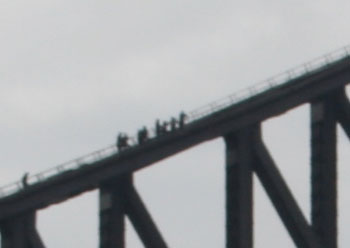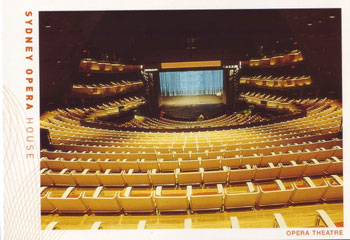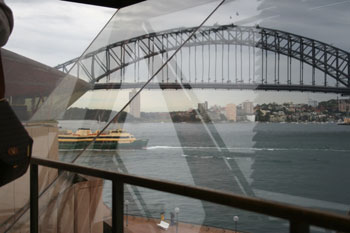| A | U | S | T | R | A | L | I | A | 2 |
0 |
0 |
5 |
 |
 |
 |
 |
Total: 70 |
Oct 21 |
 |
Manly-Sydney Quayside-Hobart
Omigod. The rain was torrential on Boston when I took off six days ago. I got off three pictures in the Mohave desert before the sun went behind the clouds. It came out again for the last 15 minutes before sunset. It was clear and hot on the Hoover dam the following morning, but that was the last I saw of the sun. Three days of rain in Las Vegas. Landed in Sydney this morning, and it is still raining.
I boarded the plane in Los Angeles at 10:30pm on Wednesday 19 October. I was extremely tired mentally and physically after three solid days on my feet and on my guard, needing to be pleasant 24x7: a stranger on the airport shuttle who saw my company shirt asked me casually about the company, how it was doing, how I liked it, turned out to be an enterprise customer. I was also smoothed out by drugs and alcohol. So it was no real surprise to stagger off the plane to find that Thursday disappeared and it is Friday already. Easy come easy go I guess. I certainly feel remarkably refreshed.
So I officially arrive in Sydney the "proper" way, in a boat. To my dismay, but logically, we don't go under the bridge, and instead pull into the quay between the Opera House and the bridge. Big shock: on this overcast, wet day, the Opera House looked a color that Bette Midler would call "putty." I was assured later by the Opera House guide that this is because the tiles that cover its surface are not white. They are two putty shades that reflect white in the sun, but at the same time provide some measure of heat protection. Sounds a little like the belly of the shuttle, and the mosaic of tiles reminded me of that.
Back on the quay, I passed an arty-farty store, with some beautiful didgeridoos in the window. I step inside, and discover, of course, that didgeridoos come in all sorts of sizes and qualities. Just as naturally, I can pick out the expensive ones without checking the price tags. But when I do, it is scary. They are several hundred dollars more than the next tier. I ask for some sort of justification. It's very simple, according to the help. These are a musical instrument, those are a souvenir. These are hollowed by termites, those are drilled out. I like the clarity and frankness. Better still, he picks one up and plays it. Then does the same with the cheaper one. Even to my uneducated ears, the difference is stark. But that's a bummer. There's no way now that I can buy an imitation, and no way that I can afford the real thing. Especially 20 minutes into the trip. I take one more wistful look around, and leave empty-handed.
After checking with the chatty receptionist about where to go for supper, I walked down to the port in search of fish and chips and a celebratory beer. On the way, I passed a record store and hearing the jazz wafting through the door, I stepped inside. There's a balding old fart behind the counter, but you can tell us apart because he's wearing a cardigan.
"I'm looking for something Australian, preferably some sort of jazz piano, can you recommend something?"
"I don't know what you like."
"Well, let me see. Brad Mehldau is one of my favorites."
"He's not Australian."
No shit Sherlock. I can't think of a suitable response, caustic or comforting, so instead I browse a little more. I pick something with an interesting cover.
"That's not the one I would have chosen."
I wish my brother Chris was here to enjoy the situation, and to come up with just the right crushing response with which to make a graceful but devastating exit, but I'm alone and speechless. Instead I grab all the CD's by this particular musician, and ask the cardigan to make a choice. He does, he puts it on, I don't like it. While I'm listening, his mother calls, and clearly is telling him that his dinner is on the table. He assures her he'll be home shortly. I thank him for letting me listen and beat a retreat for the door.
"Sorry I was rushed" he calls as I let the door hit me in the ass. I feel a great sense of relief that I didn't buy my way out of the moment.
I continued on down to the harbor, and the recommended chippy, which appropriately is right on the water, I ask which fish I should try. Can't remember the name, but it was excellent... so was the beer...
|
|
|
|
| Manly Sydney Opera House Prior to the Sydney Opera House, Sydney had no adequate dedicated music venue. Orchestral concerts were given in its Town Hall, and staging opera was almost impossible due to the lack of suitable stages. The appointment of Sir Eugene Goosens in 1947 brought into Sydney's musical life a focal point for the need to create a better venue for the performing arts. Goosens told reporters that his plans included the creation of a concert hall suitable for opera as well as orchestral performances. However, apart from occasional public announcements and exhortation from Goosens, nothing happened for seven more years. Finally, late in 1954, the State Government of New South Wales, finding itself increasingly embarrassed by its own inaction, became involved in a moderately supportive manner. The Premier of the day, Joseph Cahill, set up the committee which got the project under way. He also set up an appeal fund to raise money for the building. When it became obvious that the fund would not even raise the $7 million the Opera House was first estimated to cost, Mr Cahill introduced the Opera House Lotteries. The original appeal fund raised about $900,000 and the rest of the $102 million that the Opera House ended up costing came from the profits of the lottery. The building was completely paid for by July 1975. The committee set up by the Government selected the site for the building. Known as Bennelong Point, it was named after the first Aborigine to speak English, who was born on the site. Until this time, it was used as wharfing area and had a rather unsightly tram storage barn prominently occupying much of the site. An international competition was organized for the design of a performing arts complex, and although this was well known, the misnomer "Opera House" caught on. Design entrants were free to choose any approach that they wished, and that there were no limits to the cost of the structure. 233 design entries were submitted. The winner , announced in January 1957, was the Danish architect Jorn Utzon. It was originally envisaged that it would take four years to build the Opera House; in actual fact, it wasn't completed until mid 1973. Construction of the building commenced in March 1959. The original design called for two theatres, but at this point the government changed the requirements for the building now required that four theatres be incorporated into the design—a large hall for opera, ballet, and large scale symphony concerts capable of seating 3,000-3,500 people, and a smaller hall for drama, chamber music and recitals, capable of seating approx 1,200 people. Recently, some internal changes to the structure have enabled a fifth theatre to be created. The original design was so boldly conceived that it proved structurally impossible to build. After four years of research Utzon altered his design and gave the roof vaults a defined spherical geometry. This enabled the roofs to be constructed in a pre-cast fashion, greatly reducing both time and cost. The project was subject to many delays and cost over-runs, and (probably unfairly) Utzon was often blamed for these. A new government was elected in NSW in 1965, partly on the campaign promise to "do something" about the cost overruns with the design. The government withheld fee payments to Utzon and refused to agree to his design ideas and proposed construction methods. This pretty much forced Utzon to resign, which he did in February 1966 as Stage II was nearing completion. The first performance was in the Opera Theatre on 28 September 1973, was The Australian Opera performed War and Peace by Prokofiev. The Sydney Opera House was officially opened by Her Majesty Queen Elizabeth II on 20 Oct 1973. The roofs are covered with exactly 1,056,056 Swedish ceramic tiles arranged in 4,253 pre-cast lids. The exterior and interior walls, stairs and floors are faced with pink aggregate granite which was quarried at Tarana in New South Wales. The two woods used extensively to decorate the interiors are brush box and white birch plywood which were both cut in northern NSW. There are 6,225 sq m (67,000 sq ft) of glass, made in France, in the mouths of the roofs and other areas of the building. It is in two layers - one plain and the other demi-topaz tinted. About 2,000 panes in 700 sizes were installed. |
||




